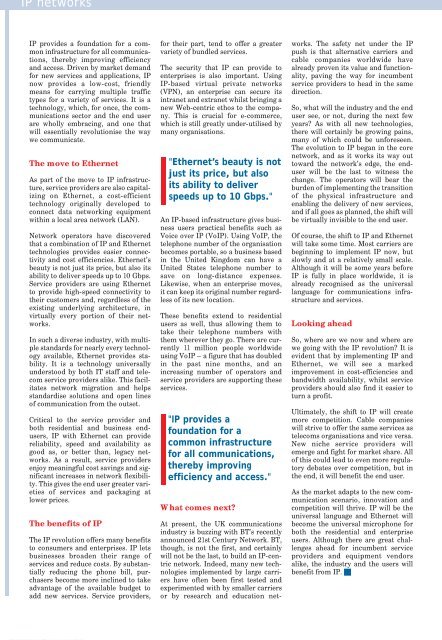Authors include: - Connect-World
Authors include: - Connect-World
Authors include: - Connect-World
You also want an ePaper? Increase the reach of your titles
YUMPU automatically turns print PDFs into web optimized ePapers that Google loves.
IP networks<br />
IP provides a foundation for a commoninfrastructureforallcommunications,<br />
thereby improving efficiency<br />
andaccess.Drivenbymarketdemand<br />
for new services and applications, IP<br />
now provides a low-cost, friendly<br />
means for carrying multiple traffic<br />
types for a variety of services. It is a<br />
technology,which,foronce,thecommunications<br />
sector and the end user<br />
are wholly embracing, and one that<br />
will essentially revolutionise the way<br />
wecommunicate.<br />
ThemovetoEthernet<br />
As part of the move to IP infrastructure,serviceprovidersarealsocapitalizing<br />
on Ethernet, a cost-efficient<br />
technology originally developed to<br />
connect data networking equipment<br />
withinalocalareanetwork(LAN).<br />
Network operators have discovered<br />
thatacombinationofIPandEthernet<br />
technologies provides easier connectivityandcostefficiencies.Ethernet’s<br />
beautyisnotjustitsprice,butalsoits<br />
abilitytodeliverspeedsupto10Gbps.<br />
Service providers are using Ethernet<br />
to provide high-speed connectivity to<br />
theircustomersand,regardlessofthe<br />
existing underlying architecture, in<br />
virtually every portion of their networks.<br />
Insuchadiverseindustry,withmultiplestandardsfornearlyeverytechnology<br />
available, Ethernet provides stability.<br />
It is a technology universally<br />
understoodbybothITstaffandtelecomserviceprovidersalike.Thisfacilitates<br />
network migration and helps<br />
standardise solutions and open lines<br />
ofcommunicationfromtheoutset.<br />
Critical to the service provider and<br />
both residential and business endusers,<br />
IP with Ethernet can provide<br />
reliability, speed and availability as<br />
good as, or better than, legacy networks.<br />
As a result, service providers<br />
enjoymeaningfulcostsavingsandsignificantincreasesinnetworkflexibility.Thisgivestheendusergreatervarieties<br />
of services and packaging at<br />
lowerprices.<br />
ThebenefitsofIP<br />
TheIPrevolutionoffersmanybenefits<br />
toconsumersandenterprises.IPlets<br />
businesses broaden their range of<br />
servicesandreducecosts.Bysubstantially<br />
reducing the phone bill, purchasersbecomemoreinclinedtotake<br />
advantage of the available budget to<br />
add new services. Service providers,<br />
for their part, tend to offer a greater<br />
varietyofbundledservices.<br />
The security that IP can provide to<br />
enterprises is also important. Using<br />
IP-based virtual private networks<br />
(VPN), an enterprise can secure its<br />
intranetandextranetwhilstbringinga<br />
newWeb-centricethostothecompany.<br />
This is crucial for e-commerce,<br />
whichisstillgreatlyunder-utilisedby<br />
manyorganisations.<br />
"Ethernet’s beauty is not<br />
just its price, but also<br />
its ability to deliver<br />
speeds up to 10 Gbps."<br />
AnIP-basedinfrastructuregivesbusiness<br />
users practical benefits such as<br />
VoiceoverIP(VoIP).UsingVoIP,the<br />
telephonenumberoftheorganisation<br />
becomesportable,soabusinessbased<br />
in the United Kingdom can have a<br />
United States telephone number to<br />
save on long-distance expenses.<br />
Likewise, when an enterprise moves,<br />
itcankeepitsoriginalnumberregardlessofitsnewlocation.<br />
These benefits extend to residential<br />
users as well, thus allowing them to<br />
take their telephone numbers with<br />
themwherevertheygo.Therearecurrently<br />
11 million people worldwide<br />
usingVoIP–afigurethathasdoubled<br />
in the past nine months, and an<br />
increasing number of operators and<br />
serviceprovidersaresupportingthese<br />
services.<br />
"IP provides a<br />
foundation for a<br />
common infrastructure<br />
for all communications,<br />
thereby improving<br />
efficiency and access."<br />
Whatcomesnext<br />
At present, the UK communications<br />
industryisbuzzingwithBT’srecently<br />
announced21stCenturyNetwork.BT,<br />
though, is not the first, and certainly<br />
willnotbethelast,tobuildanIP-centricnetwork.Indeed,manynewtechnologies<br />
implemented by large carriers<br />
have often been first tested and<br />
experimentedwithbysmallercarriers<br />
or by research and education networks.<br />
The safety net under the IP<br />
push is that alternative carriers and<br />
cable companies worldwide have<br />
alreadyprovenitsvalueandfunctionality,<br />
paving the way for incumbent<br />
serviceproviderstoheadinthesame<br />
direction.<br />
So,whatwilltheindustryandtheend<br />
user see, or not, during the next few<br />
years As with all new technologies,<br />
therewillcertainlybegrowingpains,<br />
many of which could be unforeseen.<br />
TheevolutiontoIPbeganinthecore<br />
network, and as it works its way out<br />
toward the network’s edge, the enduser<br />
will be the last to witness the<br />
change. The operators will bear the<br />
burdenofimplementingthetransition<br />
of the physical infrastructure and<br />
enablingthedeliveryofnewservices,<br />
andifallgoesasplanned,theshiftwill<br />
bevirtuallyinvisibletotheenduser.<br />
Ofcourse,theshifttoIPandEthernet<br />
willtakesometime.Mostcarriersare<br />
beginning to implement IP now, but<br />
slowlyandatarelativelysmallscale.<br />
Althoughitwillbesomeyearsbefore<br />
IP is fully in place worldwide, it is<br />
already recognised as the universal<br />
language for communications infrastructureandservices.<br />
Lookingahead<br />
So, where are we now and where are<br />
wegoingwiththeIPrevolutionItis<br />
evident that by implementing IP and<br />
Ethernet, we will see a marked<br />
improvement in cost-efficiencies and<br />
bandwidth availability, whilst service<br />
providersshouldalsofinditeasierto<br />
turnaprofit.<br />
Ultimately, the shift to IP will create<br />
more competition. Cable companies<br />
willstrivetoofferthesameservicesas<br />
telecomsorganisationsandviceversa.<br />
New niche service providers will<br />
emergeandfightformarketshare.All<br />
ofthiscouldleadtoevenmoreregulatorydebatesovercompetition,butin<br />
theend,itwillbenefittheenduser.<br />
Asthemarketadaptstothenewcommunication<br />
scenario, innovation and<br />
competitionwillthrive.IPwillbethe<br />
universal language and Ethernet will<br />
becometheuniversalmicrophonefor<br />
both the residential and enterprise<br />
users. Although there are great challenges<br />
ahead for incumbent service<br />
providers and equipment vendors<br />
alike, the industry and the users will<br />
benefitfromIP.<br />
16

















